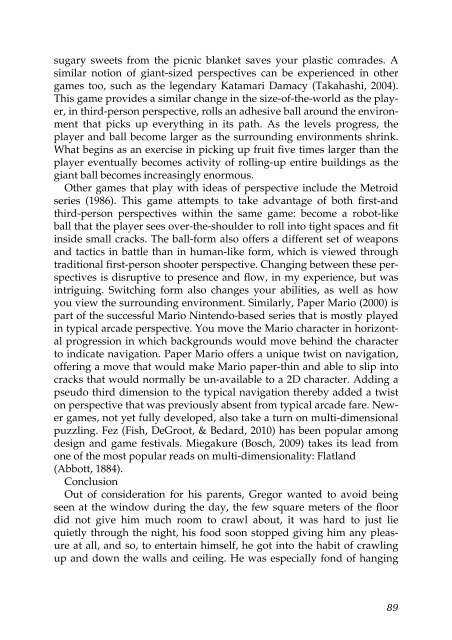Well Played 2.0: Video Games, Value and Meaning - OpenLibra
Well Played 2.0: Video Games, Value and Meaning - OpenLibra
Well Played 2.0: Video Games, Value and Meaning - OpenLibra
Create successful ePaper yourself
Turn your PDF publications into a flip-book with our unique Google optimized e-Paper software.
sugary sweets from the picnic blanket saves your plastic comrades. A<br />
similar notion of giant-sized perspectives can be experienced in other<br />
games too, such as the legendary Katamari Damacy (Takahashi, 2004).<br />
This game provides a similar change in the size-of-the-world as the player,<br />
in third-person perspective, rolls an adhesive ball around the environment<br />
that picks up everything in its path. As the levels progress, the<br />
player <strong>and</strong> ball become larger as the surrounding environments shrink.<br />
What begins as an exercise in picking up fruit five times larger than the<br />
player eventually becomes activity of rolling-up entire buildings as the<br />
giant ball becomes increasingly enormous.<br />
Other games that play with ideas of perspective include the Metroid<br />
series (1986). This game attempts to take advantage of both first-<strong>and</strong><br />
third-person perspectives within the same game: become a robot-like<br />
ball that the player sees over-the-shoulder to roll into tight spaces <strong>and</strong> fit<br />
inside small cracks. The ball-form also offers a different set of weapons<br />
<strong>and</strong> tactics in battle than in human-like form, which is viewed through<br />
traditional first-person shooter perspective. Changing between these perspectives<br />
is disruptive to presence <strong>and</strong> flow, in my experience, but was<br />
intriguing. Switching form also changes your abilities, as well as how<br />
you view the surrounding environment. Similarly, Paper Mario (2000) is<br />
part of the successful Mario Nintendo-based series that is mostly played<br />
in typical arcade perspective. You move the Mario character in horizontal<br />
progression in which backgrounds would move behind the character<br />
to indicate navigation. Paper Mario offers a unique twist on navigation,<br />
offering a move that would make Mario paper-thin <strong>and</strong> able to slip into<br />
cracks that would normally be un-available to a 2D character. Adding a<br />
pseudo third dimension to the typical navigation thereby added a twist<br />
on perspective that was previously absent from typical arcade fare. Newer<br />
games, not yet fully developed, also take a turn on multi-dimensional<br />
puzzling. Fez (Fish, DeGroot, & Bedard, 2010) has been popular among<br />
design <strong>and</strong> game festivals. Miegakure (Bosch, 2009) takes its lead from<br />
one of the most popular reads on multi-dimensionality: Flatl<strong>and</strong><br />
(Abbott, 1884).<br />
Conclusion<br />
Out of consideration for his parents, Gregor wanted to avoid being<br />
seen at the window during the day, the few square meters of the floor<br />
did not give him much room to crawl about, it was hard to just lie<br />
quietly through the night, his food soon stopped giving him any pleasure<br />
at all, <strong>and</strong> so, to entertain himself, he got into the habit of crawling<br />
up <strong>and</strong> down the walls <strong>and</strong> ceiling. He was especially fond of hanging<br />
89

















